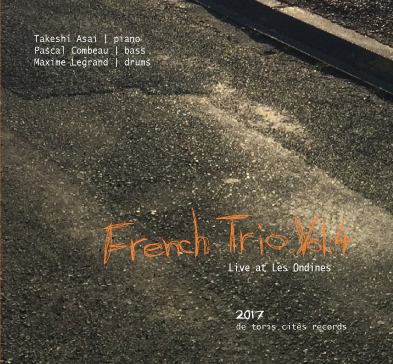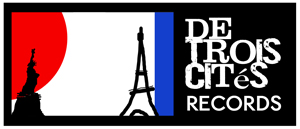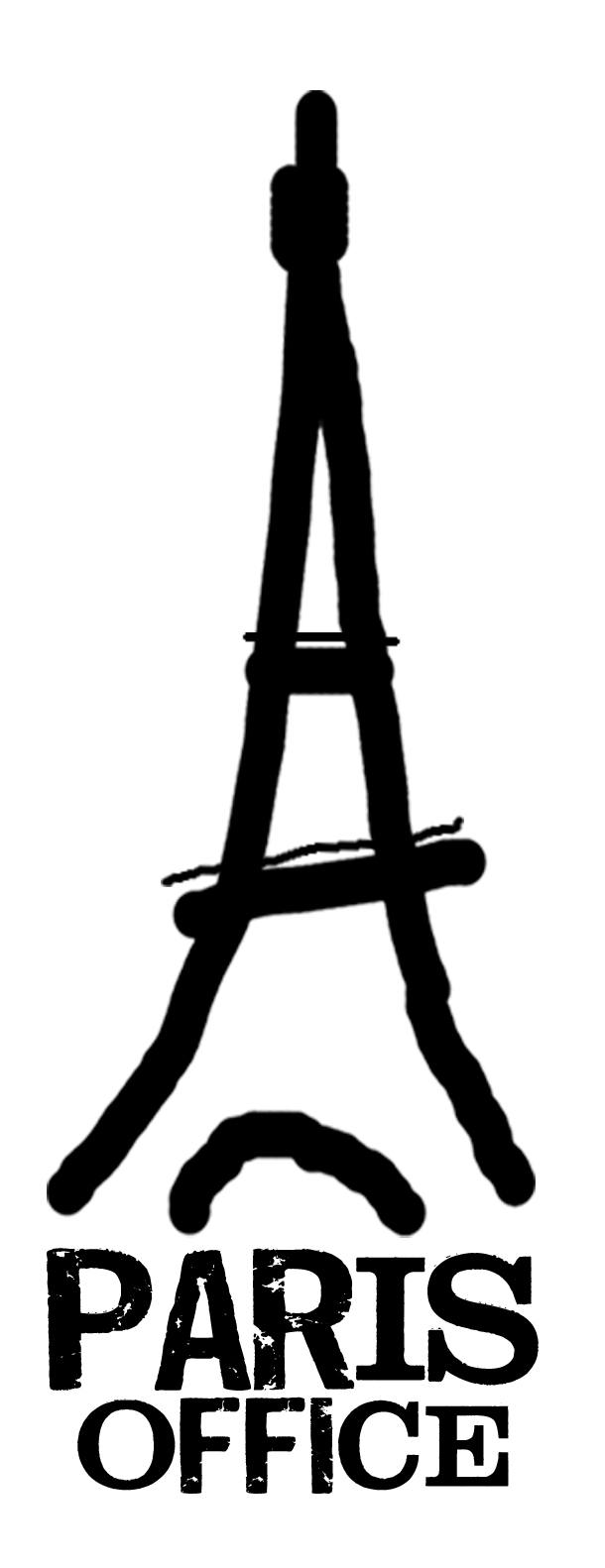|
Tweet
Takeshi Asai
Takeshi Asai | piano
Total Duration 63:36
All songs composed by Takeshi Asai (BMI / Takeshi Asai Music)
except 1. The Fool on the Hill by Lennon-McCartney, 5. Caravan by
Duke Ellington and St. Thomas by Sonny Rollins
Liner Notes
English
français
日本語
English
Takeshi Asai – French Trio, Vol 4
It took JRR Tolkien four volumes to tell the complete story of the War of the Ring and Richard Wagner four operas to tell the story of the Niebelungenlied. Beginning in 2014, Takeshi Asai embarked on a vivid and romantic tale of his own with bassist Pascal Combeau and drummer Maxime Legrand. The three of them became a single-entity triumvirate—dare I say Trinity—of Jazz beauty, improvisation, and expression.
In the Summer of 2017, Takeshi returned to France to perform at the wondrous Les Ondines with its beautiful setting and rapturous atmosphere. Then again, these three could play in a barn and make it feel like Carnegie Hall. They create their own atmosphere and carry the beauty that is within them into whatever venue they choose.
Early in 2017, Takeshi was speaking about his musical influences and he realized that he came to music through the Beatles. That interview created a longing to take one of the Beatles’ pieces and give it the Takeshi Jazz treatment. The result is the first track, Fool on the Hill, which Takeshi rearranged from 4/4 to 5/4 and 6/8 and even free meter which Pascal and Maxime absorbed and enhanced with their unique comprehension of just what Takeshi intends.
Takeshi credits the Beatles for him being a Jazz artist today. Just one more reason to praise the Beatles.
Tearful Eyes is an original and was composed in 1993. Inspired by Japanese poet Kenji Miyazawa, Takeshi could never quite get the piece to sound like he desired. One month before departing for France, the song came back to him, assured that Pascal and Maxime would know just what to do with it. They knew exactly what to do with it.
“I wanted to avoid any “cheesy” clichés,” Takeshi explains. “Instead I wanted to have a swing-feel in the straight-8th, which has been so rare and hard to achieve. But, I did thanks to my great bandmates.”
The results are extraordinary. Takeshi’s breath-taking melody over the swinging bass and drums is what Jazz is all about. A piece written 14 years before being performed, Tearful Eyes came to life at just the right moment with just the right artists. They knew exactly what to do with it.
37 Ans is another Takeshi original. The title refers to the intervening 37 years since his Middle School days and meeting up with old friends on social media.
Takeshi explains, “I wondered what the 37 years was like for everyone. It might have been fast, or slow, it might have been hard or not. Suddenly, I wanted to write a song about it. To express the strangeness of the time, I wanted to stretch the time, instead of using steady beats.”
It is wistful and wondering with expectant pauses and warm rests. As much about what happened to those old friends and acquaintances in those passing years, the question emerges, “What happened to me?”
If one should question the connection between French Trio, Vol. 3 and the present volume, Coming Home was written by Takeshi on the day he returned home from France after recording Vol. 3.
“I am usually hit by a heavy jet-lag and need a week to get back to business,” he remembered, “but last year, as the tour in France was so successful, I could net feel tired at all. Instead, I got up and wrote this song thanking for my safe journey in France and coming home in New York.”
It carries the same lovely bounce and buoyancy expressed so often in French Trio, Vol. 3. Pascal’s solo is like an encore to the work he presented in the previous expedition.
As for Caravan, it is a work that never fails to please and impress. So often a big band standard, set within this remarkable trio, it takes on a new life and new stride. Maxime makes significant departures from the standard drumming approach but does so in a way that makes one think that it always should have been done this way. Takeshi’s improvisations are electrifying, laying off the regular melody in the B section after Pascal’s stunning bass line. The whole piece swings just like it should.
Dix is Takeshi’s tribute to Dixieland. It was written in the same year as Tearful Eyes and, like that song, it took this long and this group to arrive at just the right feel. The extended A section yielded a surprising result. It is uplifting and warming.
I Remember the Castle appears on Vols 1, 2, and 4. Takeshi explains, “Someone in the jazz industry said ‘There are no masterpieces in jazz. There are only master performances.’ I totally agree. Or at least, I use that as an excuse to put this song for the third time on French Trio, Vol. 4. Also, I want to show how French Trio has developed over the last five years. Maxime’s fabulous drum solo at the end, which starts with his hand beating, alone is a big reason to have everyone in the world to listen to this performance.”
It is indeed a piece that bears repeating and developing. This is a master performance of a Takeshi masterpiece. There, I said it.
During their first encore performance five years ago, French Trio played Sonny Rollins’ St. Thomas. When the trio returned for their encore in the Summer tour of 2017 at Les Ondines, Pascal called this song again. It is a song everyone in Jazz knows and it is the simple joy of the pleasure and the power of a good groove. Takeshi calls it “the simple truth of the joy of music.”
After French Trio, Vol 1, I thought that Takeshi was someone I like. After Vol 2, I thought that he was one of the excellent and emerging pianists in Jazz. After Vol. 3, he stood alongside my favorite artists in all of Jazz. Now, with the release of Vol 4, I think he just might be a god.
français
Takeshi Asai – French Trio, Vol 4
Il a fallu quatre tomes à J.R.R. Tolkien pour raconter l'histoire complète du Seigneur des anneaux et quatre opéras à Richard Wagner pour raconter l'histoire du Niebelungenlied. En 2014, Takeshi Asai s'est embarqué, avec le bassiste Pascal Combeau et le batteur Maxime Legrand, dans son propre périple vivace et romantique. Les trois musiciens sont devenus un triumvirat monolithique – si j’osais dire, une trinité – de la beauté, de l’improvisation et de l’expression du jazz.
Au cours de l’été 2017, Takeshi est revenu en France pour se produire dans le cadre somptueux et l’atmosphère envoutante des Ondines. Encore qu’il est vrai que ces trois artistes pourraient jouer dans une grange et donner l’impression d’être à Carnegie Hall. Ils créent leur propre ambiance et transmettent leur beauté intérieure à la salle de leur choix.
Au début de l’année 2017, Takeshi avait parlé de ses influences musicales et il s’était rendu compte qu'il était venu à la musique grâce aux Beatles. Cet interview avait créé l’envie de reprendre l'un des morceaux des Beatles et de le mettre à la sauce jazz Takeshi. Le premier morceau, « Fool on the Hill », en est le résultat, et Takeshi l’a réarrangé d’un 4/4 à un 5/4 et 6/8 et même en tempo libre que Pascal et Maxime ont intégré et amélioré avec leur compréhension unique de ce que Takeshi attendait.
Takeshi dit que s’il est un artiste de jazz aujourd'hui, c’est aux Beatles qu’il le doit. C’est encore une raison supplémentaire de remercier les Beatles.
« Tearful Eyes » est un morceau original et a été composé en 1993. Inspiré par le poète japonais Kenji Miyazawa, Takeshi n'avait jamais été tout à fait satisfait du résultat en termes de sonorité. Un mois avant de partir pour la France, la chanson lui est revenue, et il s’est dit que Pascal et Maxime sauraient quoi en faire. Ils ont su exactement quoi en faire.
« Je voulais éviter tout cliché mielleux », explique Takeshi. « À la place, je voulais avoir une sensation de swing dans les croches binaires, ce qui a été si rare et difficile à réaliser. Mais, j’ai réussi grâce à mes incroyables acolytes. »
Le résultat est extraordinaire. Une mélodie de Takeshi à vous couper le souffle, accompagnée d’une basse et d’une batterie qui swing, on y retrouve la définition même du jazz. Un morceau écrit 14 ans avant d'être interprété, « Tearful Eyes » a pris vie exactement au bon moment et avec les bons artistes. Ils savaient exactement quoi en faire.
« 37 Ans » est un autre titre original de Takeshi. Le titre se réfère aux 37 ans qui se sont écoulés depuis ses années collège et les retrouvailles de ses anciens amis sur les réseaux sociaux.
Takeshi explique : « Je me suis demandé ce que représentait ces 37 ans pour chacun d’entre nous. Ils ont pu passer très rapidement ou très lentement, ils ont pu être difficiles ou non. Tout à coup, je voulais écrire une chanson à ce sujet. Pour exprimer l'étrangeté de l'époque, je voulais étirer le temps, au lieu d'utiliser des battements réguliers. »
Le morceau exprime un mélange de mélancolie et de questionnement avec des pauses expectatives et des temps de repos chaleureux. On s’interroge tout autant de ce qui est arrivé à ces anciens amis et connaissances durant toutes ces années, qu’à soi-même : « Mais que m'est-il arrivé ? ».
Si l'on devait s’interroger sur le rapport entre French Trio, Vol. 3 et le volume actuel, Coming Home a été écrit par Takeshi le jour où il est rentré de France après avoir enregistré Vol. 3.
« Je suis généralement terrassé par le décalage horaire et j'ai besoin d'une semaine pour me remettre au travail », raconte-t-il, « mais l'année dernière, comme la tournée en France avait eu tellement de succès, je n’arrivais pas à sentir la fatigue. Au lieu de ça, je me suis levé et j'ai écrit cette chanson comme un remerciement pour mon voyage en France et mon retour sain et sauf à New York ».
Il émane le même rebond et la même légèreté agréable si souvent exprimés dans French Trio, Vol. 3. Le solo de Pascal résonne comme un écho au travail qu'il avait présenté lors de l'expédition précédente.
Quant à Caravan, c'est une œuvre qui ne cesse jamais de donner du plaisir et d'impressionner. Si souvent un classique des big bands, une fois confiée à ce trio remarquable, elle reprend vie et un nouveau tempo. Maxime prend beaucoup de liberté par rapport au rythme de la batterie d’origine, mais il le fait d'une manière qui fait penser qu'elle aurait toujours dû être jouée de cette façon. Les improvisations de Takeshi sont électrisantes, abandonnant la mélodie d’origine dans la section B après la magnifique ligne de basse de Pascal. Le morceau entier swing comme il se doit.
« Dix » est un hommage de Takeshi à Dixieland. Il a été écrit la même année que Tearful Eyes et, tout comme ce dernier, il a fallu tout ce temps et ce groupe en particulier pour arriver à la bonne alchimie. La section A rallongée a donné un résultat surprenant. C'est éblouissant et réchauffant.
« I Remember the Castle » apparaît sur les Vols 1, 2, et 4. Takeshi explique: « Quelqu'un dans l'industrie du jazz a déclaré : "Il n'y a pas de chefs-d'œuvre dans le jazz. Il n'y a que des interprétations de maître". Je suis totalement d'accord. Ou du moins, j'utilise ce prétexte pour mettre ce morceau pour la troisième fois sur French Trio, Vol. 4. En outre, je souhaite montrer comment le French Trio s'est développé au cours de ces cinq dernières années. Le fabuleux solo de batterie de Maxime à la fin, qui commence par un battement de sa main, est une raison suffisante pour justifier que tout le monde écoute cette performance ».
C'est en effet un morceau qui gagne à être répété et à se développer. C'est une performance de maître d'un chef-d'œuvre de Takeshi. Voilà, je l'ai dit.
Lors de leur premier rappel il y a cinq ans, French Trio a repris St. Thomas de Sonny Rollins. Durant la tournée de l'été 2017, lorsque le trio est revenu pour leur bis aux Ondines, Pascal a de nouveau proposé ce morceau. C'est un morceau que tout le monde connaît dans le jazz, et il représente la joie simple du plaisir et de la puissance d'un bon groove. Takeshi l'appelle « la vérité simple de la joie de la musique ».
Après French Trio, Vol 1, Takeshi était quelqu'un que j’appréciais. Après Vol 2, je le considérais comme l'un des meilleurs pianistes émergents du jazz. Après Vol. 3, il faisait partie de mes artistes préférés dans le monde du jazz. Maintenant, avec la sortie de Vol 4, je pense qu'il pourrait tout simplement être un dieu.
日本語
「French Trio, Vol 4」by Takeshi Asai (浅井岳史) ライナーノーツ
『指輪物語』の作家、J・R・Rトールキンは、『指輪戦争』の全貌を語り尽くすのに4巻を要した。作曲家ワーグナーは、「ニーベルングの指環」の物語を語るために4部作のオペラを作曲した。2014年初頭、浅井岳史は彼自身の色彩豊かでロマンチックな音楽物語を語るために、フランスのツアーをスタートさせた。そしてこのトリオはジャズが持つ音楽美、即興演奏、表現力においてトライアンヴィレート(三頭政治)-いや、誤解を恐れずに言うなら「三位一体」とも呼ぶべき存在へと進化を遂げたのである。
2017年夏、浅井は南フランスのレ・ゾンディーヌという美しい会場で再びファンの熱気に迎えられフランスでの凱旋公演を大成功させた。このピアノトリオは、そもそも納屋のような会場でも一瞬でカーネギーホールに変えてしまうくらい見事な演奏をする。彼らにしか醸し出せない独特の世界観を表現し、そこがどんな場所であろうと、このフレンチトリオならではの美しさをいかんなく発揮して、会場全体を彼らの色に染めてしまうのだ。
2017年春、浅井はロンドンのジャズ誌でのインタビューで自分が影響を受けた音楽家について語ってくれた。それによると、彼を音楽へと導いてくれたのは中学の時に聞いたビートルズだったという。そしてそのイギリス人とのインタビューがきっかけで、今回のツアーで、ビートルズの作品を浅井風にジャズアレンジしてみたいという渇望が湧き起こってきたそうだ。この着想が実を結んだものが1曲目の「Fool on the Hill」。浅井が原曲の4/4拍子を5/4拍子、さらに6/8拍子からタイムを刻まないフリーへと発展させたものをパスカルとマキシムがうまく呼応し、浅井の意図する音楽に独自の解釈を加えて膨らませたレコーディングができあがった。
浅井はジャズアーティストとしての今の自分があるのはビートルズのおかげだという。ビートルズがなければ今の浅井はなかったということか。ビートルズを称える理由がもう1つ増えた。
2曲目「Tearful Eyes」は浅井のオリジナル曲で、1993年に作曲された。中学の国語の時間に習った宮沢賢治にインスピレーションを得て作曲したものの、なかなか思うような音に仕上がらず、長い間お蔵入りしていたという。ところがフランスへと旅立つ一ヶ月前に、急遽この曲が再登場することになった。そして、パスカルとマキシムに任せればうまく行くという確信が膨らんで来たという。予感は的中、二人のサイドメンは浅井の期待を裏切らない素晴らしい演奏をしてくれた。「使い古された、陳腐な作品になってしまうことをどうしても避けたかった」と浅井は言う。「僕が目指していたのは8分音符のストレートのスウィング感だった。このスウィング感は非常に珍しく、形にするのが困難な目標だったけれど、すばらしいミュージシャンのおかげで実現させることができた」。
こうして、類い稀な傑作が誕生することになった。息を呑むほど美しい浅井の旋律を、アコースティックベースとドラムのスウィングに掛け合わせた本作は、まさにジャズの真髄を極めた作品に仕上がっている。14年間、日の目を見ることがなかった「Tearful Eyes」は、絶好のタイミングで、最高のアーティストたちの手によって息を吹き返した。彼らは何をどうすればよいか、すべて知り尽くしていたのだ。
「37 Ans(トランセタン)」もまた浅井のオリジナル作品である。このタイトルは中学時代から37年が経過し、Lineで昔の同級生とつながったことから生まれた作品だそうだ。「『37年という歳月を、みんなどのように生きてきたのだろう』と思った。あっという間だったと言う人も、遅かったという人もいるかもしれない。大変な思いをした人も、そうでない人もいるだろう。そう思ったら突然、曲が書きたくなった。時間という不思議な空間を表現するために、一定のビートを使わずに、タイムを自由自在に伸ばしてみたりしたいと思った」そうだ。
愁いを含んだ調子に、小粋な一時停止と、ほっとさせられる休符がちりばめられ、時間という観念の不思議さが際立つ作品となっている。過ぎた年月を振り返り、旧友や知人に思いを馳せると同時に、「自分はどんな人生を送ってきたのだろう」という自問自答が湧き起こってくる。
「French Trio, Vol. 3」と本作とのつながりを知りたいと思う方には、「Coming Home」をお勧めしたい。これはVol. 3のレコーディングが終わってフランスから帰国した次の日に浅井が一瞬のインスピレーションで書いた作品である。「いつもならひどい時差ぼけで、元に戻るのに一週間はかかるけど」と浅井は当時を振り返る。「昨年はフランスツアーが大成功に終わったから、まったく疲れは感じなかった。逆に早く起き出して来て、フランスでサポートしていただいた多くの方への感謝とニューヨークの自宅に無事に帰宅できたことへの感謝を感じていたら、この曲が突然浮かんできた」。
本作には「French Trio, Vol. 3」に顕著に見られたものと同じ、魅力的なバウンス感と快活なリズムが生きている。パスカルのソロは、過去のツアーで披露してきた演奏のアンコールのようだ。
「Caravan」は間違いなく、喜びと感銘を与えてくれる作品だ。ビッグ・バンドのスタンダードナンバーとして演奏されることも多い本作だが、この驚異的なトリオの手にかかると、新たな息吹が吹き込まれ、新たな歩み(ストライド)が始まる。マキシムはスタンダードのドラム奏法から大きく外れた演奏を見せているが、ずっと前からこうあるべきだったと思わせられてしまうほど違和感がない。浅井の即興演奏は衝撃的で、パスカルのスイングしまくるベースラインを聴かせるために、Bセクションでわざとメロディーを弾かずにコードで彼のバックを入れている。作品全体でまさに理想のスウィングが完成していると言える。
「Dix」は、浅井がディキシーランドに捧げた作品である。「Tearful Eyes」と同年に書かれた本作は、「Tearful Eyes」と同様、完璧なフィーリングにたどり着くために、長い年月を経てでも、このグループに巡り会うことが必要だった。Aセクションを通常の8小節から10小節に伸ばして、ちょっとした驚きが仕掛けられている。元気がもらえ、温かみが感じられる作品である。
「I Remember the Castle」はVol. 1、2、4に収録されている。浅井は説明する。「あるジャズ業界関係者が『ジャズに名曲なんて存在しない。あるのは名演奏だけだ』と言っていたが、僕もまったく同意見だ。少なくとも、『French Trio, Vol. 4』で三度目となるこの曲を収録するのを正当化する言い訳に使わせてもらっている。それに、ここ5年間でFrench Trioが遂げてきた進化の過程を示したいという思いもあった。ハンドドラムから始まるマキシムの最後の見事なドラムソロだけでも、世界中の人々にこのパフォーマンスを聴いてもらう大きな理由になる」。確かに、反復と発展の要素が盛り込まれた作品だ。これこそ浅井の優れた「名曲」の「名演奏」に他ならない。私はそう言い切れる。
5年前の初コンサートのアンコールで、French Trioはソニー・ロリンズの「セント・トーマス」を披露した。2017年夏のレ・ゾンディーヌでの凱旋公演のアンコールで、パスカルはこの曲を再指名した。ジャズに携わる人なら誰でも知っているおなじみのナンバーで、上質のグルーヴにしか表現できない楽しさとパワーに、純粋な喜びがこみ上げてくる。浅井はこれを「音楽の喜びという絶対的真実(the simple truth of the joy of music)」と端的に表現している。
「French Trio, Vol. 1」を聴いたとき、このアーティストはなかなか良いなと言うのが私の感想だった。Vol. 2を聴いた後は、ジャズ界屈指の新進ピアニストの1人だと思った。Vol. 3を聴いた後、浅井はすべてのジャズ作品の中で私のお気に入りアーティストの仲間入りを果たした。今回、Vol. 4となる本作を聴いて、私は今や浅井は神の域に達しているとすら思えてしまうのである。
(翻訳:ランサムはな 監修:浅井岳史)
|
Contents of this site are property of de trois cités records. Any use of these contents, in whole or in part, is prohibited without the express written consent of de trois cités records. Copyright 1995-2020 All rights reserved.



